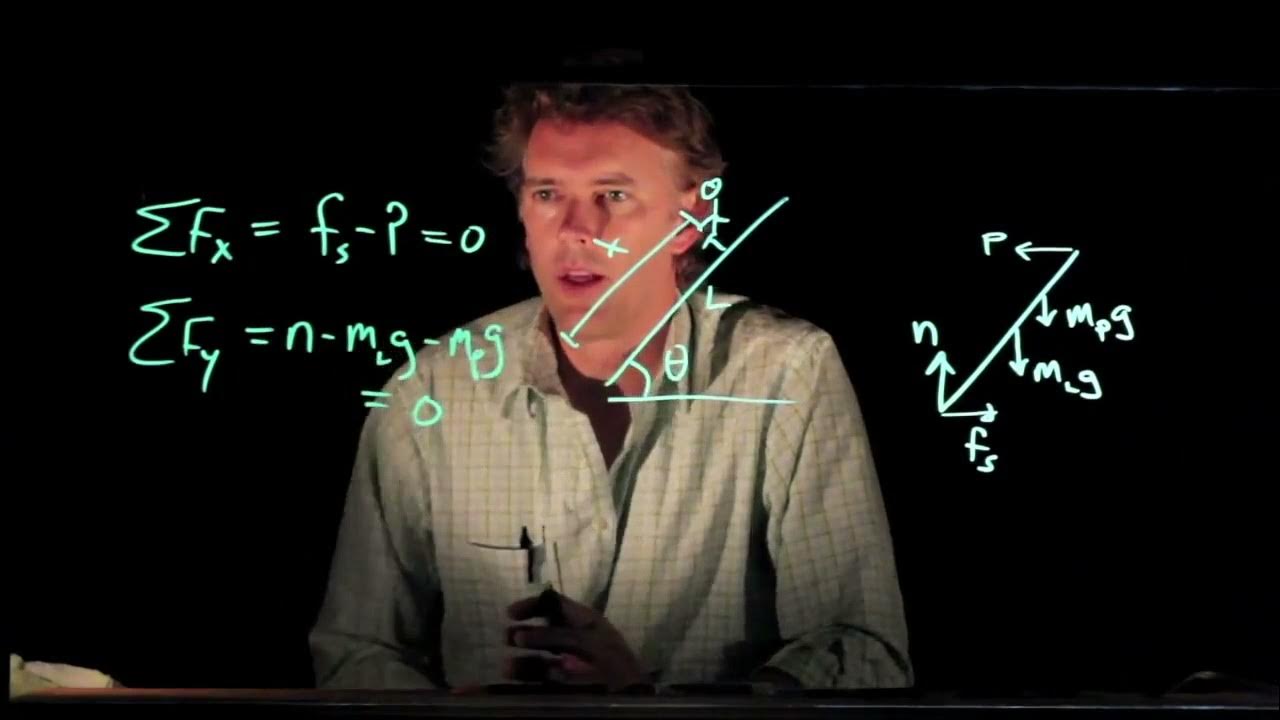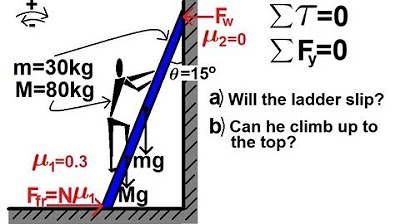Physics 15 Torque (21 of 25) More Examples: 3 T=? of Cable of Step Ladder
TLDRThe video script presents a detailed analysis of torque, focusing on a scenario involving a tall step ladder held together by a rope. The ladder is 2 meters tall, and a person weighing 70 kilograms is standing at a height of 3 meters. Assuming no friction between the ladder and the floor, the video explores the tension in the rope necessary to prevent the ladder from slipping. The problem is approached by calculating the sum of torques around different points, considering the weight of the person and the forces exerted by the floor and the rope. Using trigonometry and the concept of equilibrium, the video demonstrates how to find the tension in the rope, which is determined to be 133 Newtons. This educational content is designed to engage viewers in understanding the principles of torque and its practical applications.
Takeaways
- 📐 The problem involves a tall step ladder secured by a rope or cable to prevent slipping, with a person's weight and position being key factors in calculating tension.
- ⚖️ An assumption of no friction between the ladder and the floor is made for simplicity, which is also a safety consideration.
- 🧍 The person's mass is given as 70 kilograms, and the ladder's weight is ignored to focus on the main problem.
- 🔄 Torque equilibrium is used to solve the problem, where the sum of torques around a pivot point equals zero.
- 📏 The rope is tied at the halfway point of the ladder, and the person is located three-quarters of the way up the ladder at a height of 3 meters.
- 📐 The distances from the pivot point to the points of force application (D1 and D2) are crucial in calculating the forces at A and B.
- 🔢 The force at B (F sub B) is calculated to be 3/8 of the person's weight (mg), using the ratio of distances D1 and D2.
- 🚫 The force at A (F sub A) is the remaining force required to balance the person's weight, which is 5/8 mg.
- 🔄 By moving the pivot point to the center of the ladder, the torques due to the force at B and the string tension are analyzed to find the tension in the string.
- 🧮 The tension in the string is solved using the sine of the angle formed by the ladder and the horizontal, which is found using the cosine of the angle in the larger triangle.
- 🎢 The final calculation of the string's tension involves the sine of the angle, the person's weight, and the distances involved, resulting in a tension of 133 Newtons.
Q & A
What is the purpose of the rope or string in the ladder setup described in the video?
-The rope or string in the ladder setup is used to hold the two ends of the ladder together, preventing them from slipping outward and maintaining stability, especially since the ladder is placed on a frictionless floor.
Why is it assumed there is no friction between the ladder and the floor in the example?
-The assumption of no friction between the ladder and the floor simplifies the calculation and focuses on understanding the effects of other forces, like tension in the rope and weight, on the ladder's equilibrium.
How does the person's position on the ladder affect the tension in the rope?
-The person's position on the ladder, being three-quarters of the way up, increases the leverage and the downward force due to gravity, which in turn increases the tension required in the rope to maintain equilibrium.
What is meant by 'torque' in this context?
-Torque in this context refers to the rotational force caused by the person's weight acting at a distance from the pivot point (point A), which tends to rotate the ladder around this point.
Why must the sum of all torques about point A be zero?
-The sum of all torques about point A must be zero to achieve rotational equilibrium, meaning the ladder remains stable and doesn't rotate, ensuring the person's safety.
How is the force at point B calculated?
-The force at point B is calculated by balancing the torque produced by the person's weight against the reactive force from the floor, using the perpendicular distances from these forces to the pivot point A.
What is the significance of finding the force at point B?
-Finding the force at point B is crucial for calculating the tension in the rope, as it helps in setting up the equilibrium condition for the other side of the ladder when considering torques around a new pivot point, point C.
How do the angles of the ladder help in determining the tension in the rope?
-The angles of the ladder help determine the perpendicular distances used in the torque calculations, which are essential for correctly assessing the forces involved and ultimately finding the tension in the rope.
What role does the weight of the person play in this setup?
-The weight of the person significantly influences the system's dynamics by being the primary downward force that must be balanced by the tension in the rope and the reactive forces at points A and B for equilibrium.
Why is the tension in the rope critical for the ladder's stability?
-The tension in the rope is critical for the ladder's stability because it counteracts the outward forces exerted at the base of the ladder due to the person's weight, helping to keep the ladder from spreading apart and collapsing.
Outlines
🔍 Analyzing Torque with a Tall Step Ladder
The first paragraph introduces a physics problem involving a tall step ladder, 2 meters in height, secured by a rope or cable at its midpoint. The ladder is leaning against a wall with a person standing on it at a height of 3 meters. The goal is to find the tension in the rope. The problem assumes no friction between the ladder and the floor and ignores the ladder's weight for simplicity. The solution involves calculating the sum of torques about a pivot point, considering the forces acting on the system, including the person's weight and the forces at the ladder's ends. The person's mass is given as 70 kilograms, and the force at the bottom (B) is determined to be 3/8 of the person's weight, while the force at the top (A) is 5/8 of the person's weight. The paragraph concludes by noting that the tension in the string is yet to be found but is a step closer with the knowledge of the force at B.
📐 Calculating the Tension in the String
The second paragraph continues the problem-solving process by focusing on the right side of the ladder and the forces acting upon it. It explains that the sum of torques around a new pivot point (C) must be zero. The forces considered are the force at B (known from the previous calculation) and the unknown tension in the string (T). To find the tension, the distance from the string's point of action to the pivot (D3) is needed. The paragraph uses trigonometry to find an angle of the larger triangle formed by the ladder and the wall, which helps determine D3. After finding the angle to be 75.52 degrees, the distance D3 is calculated using the sine of this angle. With D3 known, the tension in the string is found by setting up an equation with the known force at B and solving for T, resulting in a tension of 133 Newtons.
🔗 Finalizing the Calculation for Tension
The third paragraph summarizes the process used to find the tension in the string. It reiterates the steps taken to analyze the forces and torques acting on the ladder. Initially, the forces at the bottom (B) and top (A) of the ladder were determined by considering the sum of torques about point A. With the total force exerted by the floor on the ladder equal to the person's weight (after ignoring the ladder's weight), the forces at A and B were found to be 5/8 and 3/8 of the person's weight, respectively. Then, by moving the pivot point to C and considering only the right side of the ladder, the sum of torques was set to zero, involving the force at B and the tension in the string. The paragraph concludes by emphasizing how finding the angle and subsequently D3 allowed for the calculation of the string's tension.
Mindmap
Keywords
💡Torque
💡Equilibrium
💡Tension
💡Friction
💡Mass
💡Weight
💡Pivot Point
💡Force of Reaction
💡Perpendicular Distance
💡Similar Triangles
💡Cosine and Sine
Highlights
The concept of torque is used to solve for the tension in a string holding together two ends of a tall step ladder.
A 2 meter tall step ladder is set up with a rope holding the two ends together, assuming no friction between the ladder and the floor.
A person weighing 70 kg is standing 3/4 of the way up the ladder at a height of 3 meters.
The rope is tied at the halfway point between the bottom and top of the ladder.
The weight of the ladder is ignored to simplify the problem.
The sum of all torques acting about point A (where the rope is tied) must add up to zero for equilibrium.
The forces acting on the system are the weight of the person (Mg), the force at A pushing upward, and the force at B pushing upward.
The force at A is assumed to be greater than the force at B initially.
The torque caused by the person's weight is clockwise (negative), while the torque from the force at B is counterclockwise (positive).
The perpendicular distance from the point of rotation to the line of action of the person's weight is called D1.
The force at B (F sub B) times the distance D2 is equal to the person's weight (mg) times D1 divided by the ratio D2/D1.
Solving for F sub B gives the force at B as 3/8 the weight of the person (mg).
The force at A is the full weight of the person (mg) minus the force at B, which is 5/8 mg.
To find the tension in the string, consider the right side of the ladder with only the force at B and the string tension causing torque about point C.
The sum of the torques about point C must also add up to zero.
The distance from the line of action of the string tension to the pivot point is called D3.
The full triangle of the ladder is used to find the angle between the ladder and the floor, which is 75.52 degrees.
D3 is then calculated as 2 meters times the sine of the angle (75.52 degrees).
Finally, the tension in the string is found by setting the string tension times D3 equal to the force at B (3/8 mg) times D2, and solving for the tension.
The tension in the string is calculated to be 133 Newtons.
Transcripts
Browse More Related Video

Torque Example #3: Leaning Ladder Problem

Ladder Example for Static Equilibrium

The Leaning Ladder Problem | Physics with Professor Matt Anderson | M12-22

Physics 15 Torque Example 7 (7 of 7) The Ladder Problem (should be cos(15) at end)

Physics 15 Torque (12 of 27) Example 2: Forces=? Tension=?

Leaning Ladder Equilibrium Problem: Find Minimum Angle
5.0 / 5 (0 votes)
Thanks for rating: